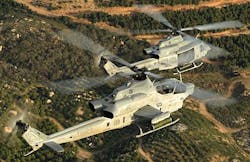Flight mission computers for Marine Corps UH-1Y and AH-1Z helicopters to come from Northrop Grumman
WOODLAND HILLS, Calif., 3 April 2012. U.S. Navy helicopter experts needed mission computers for UH-1Y utility helicopter and U.S. Marine Corps AH-1Z attack helicopter. They found their embedded computing solution from the Northrop Grumman Corp. Navigation Systems Division in Woodland Hills, Calif.
The U.S. Naval Air Systems Command (NAVAIR) at Patuxent River Naval Air Station, Md., has signed $8.9 million contract direct contract with Northrop Grumman (NYSE:NOC) to provide Gen II mission computers for UH-1Y and AH-1Z helicopters.
The dual mission computers are the heart of Northrop Grumman's Integrated Avionics System (IAS) that powers the helicopters' glass cockpits. The mission computers provide centralized avionics control, interface with the tactical moving map, and display situational awareness and health monitoring.
Additionally, the IAS and mission computers feature open, modular architecture to enable system upgrades and rapid insertion of new technologies. Northrop Grumman also provides the operational flight program software that controls the IAS.
The mission computers will be on the UH-1Y and AH-1Z helicopters that make up the Marine light attack helicopter squadrons. Critical mission data is shown on four displays.
The H-1 Upgrade program is replacing aging AH-1W and UH-1N helicopters with upgraded UH-1Y and AH-1Z aircraft to enhance commonality, reliability, and maintainability. The upgraded helicopters have 100 percent software commonality through Northrop Grumman's IAS and the same operational flight program.
For more information contact Northrop Grumman Navigation Systems online at www.es.northropgrumman.com, or Naval Air Systems Command at www.navair.navy.mil.
Follow Military & Aerospace Electronics and Avionics Intelligence news updates on Twitter

John Keller | Editor
John Keller is editor-in-chief of Military & Aerospace Electronics magazine, which provides extensive coverage and analysis of enabling electronic and optoelectronic technologies in military, space, and commercial aviation applications. A member of the Military & Aerospace Electronics staff since the magazine's founding in 1989, Mr. Keller took over as chief editor in 1995.


